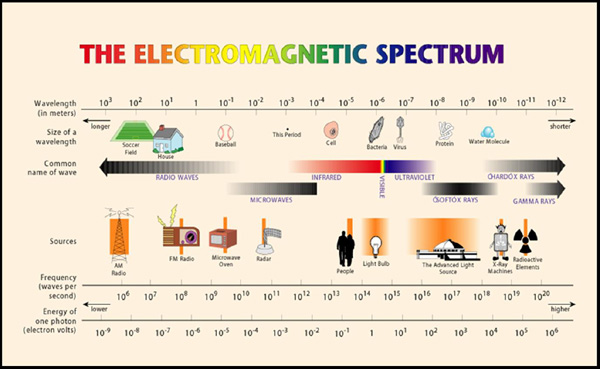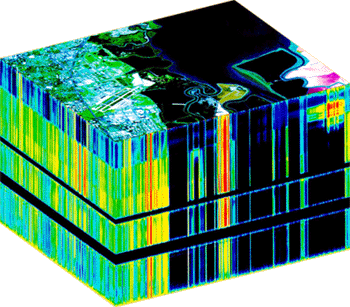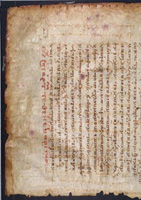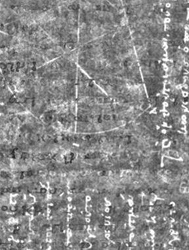Multi-Spectral Imaging of the Archimedes Palimpsest
The Multispectral Imaging of the Archimedes palimpsest was undertaken by Keith Knox, of the Boeing Corporation based in Maui, William A. Christens-Barry of Equipoise Imaging LLC, and Roger Easton, Professor of Imaging Science at RIT. Here, Roger Easton gives an overview of the imaging program.
Electromagnetic Radiation
To explain multispectral imaging, we must make a short digression into electromagnetic radiation. Radiation can be understood as waves of energy traveling through space. Radiation can vary in its intensity (that is how many waves are received or emitted with a certain period) and in their wavelength (that is, the distance between their peaks as they travel). The shorter the wavelength, the more energy the radiation has. At one extreme of the Electromagnetic spectrum are long wave radio waves that have the wavelength of football pitches. At another extreme are Gamma waves, which have a wavelength much shorter than the size of a single atom. For a short interval somewhere between these extremes is visible light. The only reason that it is visible light (often called "white light") is because humans have evolved to recognize it that way via their eyes, through the process of Natural Selection. Isaac Newton demonstrated that white light is actually made up of different spectra; red, green and blue. Thus, white light is often referred to as RGB light. At slightly longer wavelengths is infra-red light, invisible to humans but received by your skin, and recognized as heat by your body.

At slightly shorter wavelengths is the more energetic ultraviolet (UV) light, which is also received by your skin, and is energetic enough to damage it. That is how you get sunburn. Electromagnetic radiation interacts with matter in different ways, depending upon its wavelength. It is quite possible that something which is invisible in RGB light will be visible, to a camera anyway, in Infra-red light. 
Multispectral Imaging
Multispectral imaging is a digital imaging technique. Numerous photographs of an area are taken at different wavelengths of light, resulting in a digital "stack" of images. Algorithms (recipes if you like) are then written in order to enhance particular characteristics of the imaged area. In the case of the Palimpsest, obviously, we wanted to bring out the under text.


The immediate results appear to be spectacular. Above is an image of folio f.70v. The imagers succeeded in separating the spectral signature of the Archimedes ink from the parchment underneath it, and that of the prayer book on top of it. To bring out the Archimedes text even more, they then made the prayer book ink look like the parchment. Below, one can clearly see areas of text and diagrams that are invisible, or at least extremely hard to discern, under RGB light.


Despite the extraordinary appearance of these pictures, and the potential that they show for these advanced imaging techniques, the scholars were dissatisfied with the results.
- The images appeared blurry. They were not out of focus, but rather it proved difficult to register the images accurately. To take images in different wavelengths of light, different filters have to be placed in front of the lens of the camera. Unfortunately, the lens affected the path of the light, and altered the size of the image. When one image was combined with another, they did not line up correctly. This is not a problem when one is imaging large areas from space, but it is a problem when one is imaging the details of the Byzantine minuscule script in which the Palimpsest was written.
- There were lots of "artifacts" in the image. The images that the scientists produced were highly processed. When one manipulates images, one necessarily creates artifacts or "noise." Again, when trying to read the tenth century script this was a great hindrance.
- The imagers were imaging at about 300 dpi, which the scholars found insufficient to their needs. The scholars liked to “blow-up” individual characters to the size of their computer screens when they try to decipher the text, and to do this successfully, the images needed to be of a higher resolution.
- The main problem was the most unexpected. The imagers were working on the assumption that they were supposed to “strip away” the prayer book text. However, the scholars pointed out that there was no point in stripping away the payer book text unless one could literally read the Archimedes text underneath the individual prayer book characters. It was merely confusing to them to make the prayer book text look like parchment.
The Initial Experiments on the Archimedes Palimpsest were extremely useful in many ways, as Bill Christens-Barry explains, and a fruitful dialogue developed between the imagers and the scholars as to how best to use the available technology. However, they were of little use in deciphering the palimpsested text in themselves, and, when imaging on the Palimpsest began in earnest, completely different wavelengths were used, and completely different algorithms developed.